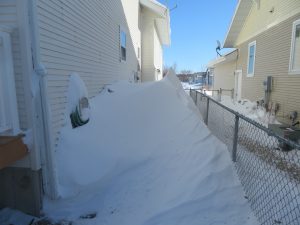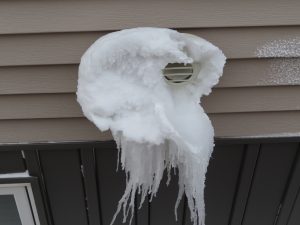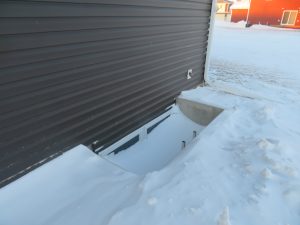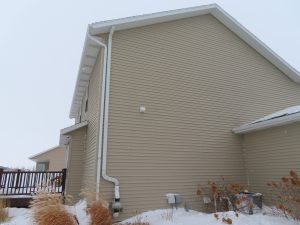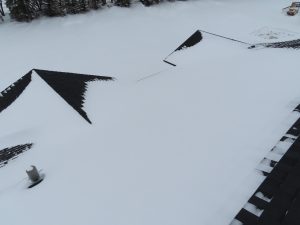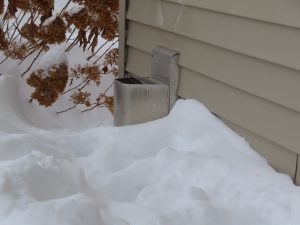Winter weather is causing safety hazards in homes in the Fargo and Moorhead area. Many home owners do not understand the possible consequences of neglecting them, or how to correct these problems. We have listed the 6 most common issues that we see on a day to day basis, and what to do to fix them.
GAS METER BURIED IN SNOW
Complications:
When the gas meter is buried in snow the regulator and meter can malfunction and may result in a hazardous situation. When the regulator on the gas meter is buried it may become clogged, affecting the supply of gas to the appliances in your home. When the snow melts it becomes wet and heavy, which can put pressure on the meter. The pressure can cause strain on the piping, and in extreme cases, it is possible that the piping could break.
What to do:
Carefully remove all snow around the gas meter – ideally by using your hands.
FURNACE PIPES FROZEN OVER
Complications:
If the air intake is blocked the heating system can shut down. Either because of lack of oxygen, or because there can be a built-in safety mechanism that will shut it off.
If the blockage is at the exhaust-vent the system might also shut down, but even worse things can happen, hazardous combustible materials including carbon monoxide (CO) can be forced back into the home. CO is odorless and colorless, and can be very harmful to both people and animals.
What to do:
Carefully remove all snow and ice from the vents and ensure that air is going in and exhaust is going out. Also, remember to install carbon monoxide detectors in your home.
WINDOW WELL FILLED WITH SNOW
Complications:
In case of an emergency, the snow will not only make it extremely difficult to get out of the window well, but the window will be completely frozen making it impossible to open.
What to do:
Shovel out all snow in your window well and make sure that the window can be opened. If you can, install a window well cover right away, or do it as soon as the weather allows it.
RADON SYSTEM OBSTRUCTED
Complications:
If you have a radon mitigation system in your home, chances are that it once was determined that the radon levels in your home were high. When the vent for the radon system is blocked the system is no longer operating properly, and radon gases will enter your home.
What to do:
- You can attempt to remove the snow and ice from the pipe, although it can be dangerous as the vent is typically at least 8-10” from the ground.
- Just let it thaw. Since dangers with high radon gases typically accumulate over a longer period of time, many are comfortable being exposed to higher levels of radon for just a few months.
- Improve the ventilation. Outside air will dilute radon inside a home, so if you have a fresh air intake vent to your return duct make sure that it is opened up. If you have an air exchanger in your home, make sure to increase the ventilation. Studies have found that air exchange systems can reduce radon with 30-50%.
- Air filtration. You cannot filter radon gases; however, you can filter radon decay particles. Radon decay particles are bi-products of radon. It is actually radon decay products that are increasing the risk of developing lung cancer when being inhaled into your lungs.
We recommend installing a MERV13 filter if your furnace is designed for that, and set your furnace fan to “ON” so air in your home is constantly circulating through the filter.
PLUMBING VENT FROZEN OVER
Complications:
When the venting system for the home plumbing is obstructed, water in the trap for toilets and other drains can siphon out allowing dangerous sewer gases to enter your home.
What to do:
If you feel like it is safe to walk your roof you can enter the roof and physically remove the blockage. Another common method is to install an insulated sleeve on your plumbing vent on the roof. There are also a large number of products on the market that can help preventing the sewer vent from freezing.
VENT FOR GAS FIREPLACE
Complications:
This can cause hazardous combustible material to enter your home, and your gas fireplace might not operate properly.
What to do:
Carefully remove snow from the vent.
 Menu
Menu

